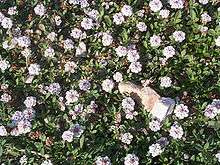Phyla dulcis
| Phyla dulcis | |
|---|---|
 | |
| Scientific classification | |
| Kingdom: | Plantae |
| (unranked): | Angiosperms |
| (unranked): | Eudicots |
| (unranked): | Asterids |
| Order: | Lamiales |
| Family: | Verbenaceae |
| Genus: | Phyla |
| Species: | P. dulcis |
| Binomial name | |
| Phyla dulcis (Trevir.) Moldenke | |
| Synonyms | |
Phyla dulcis is a species of perennial herb that is native to southern Mexico, the Caribbean (Cuba, Hispaniola, and Puerto Rico), Central America, Colombia, and Venezuela.[1] It is known by several common names, including Aztec sweet herb, bushy lippia, honeyherb, hierba dulce, and tzopelic-xihuitl (Nahuatl). Its buds are also sold as dushi or dulce (sweet in Papiamento and Spanish respectively) buttons.
Uses
This plant has historically been used as a natural sweetener and medicinal herb in its native Mexico and parts of Central America. It was used by the Aztecs and introduced to the Spanish when they arrived.
The sweet taste is caused by a sesquiterpene compound called hernandulcin, which was discovered in 1985 and named for Francisco Hernández, the Spanish physician who first described the plant in the sixteenth century.[2]
References
- 1 2 "Phyla dulcis (Trevir.) Moldenke". Germplasm Resources Information Network. United States Department of Agriculture. 2002-12-17. Retrieved 2010-01-22.
- ↑ Vandaveer, C. What is the Aztec sweet herb? killerplants.com
External links
![]() Media related to Phyla dulcis at Wikimedia Commons
Media related to Phyla dulcis at Wikimedia Commons
![]() Data related to Phyla dulcis at Wikispecies See Lippia dulcis.
Data related to Phyla dulcis at Wikispecies See Lippia dulcis.